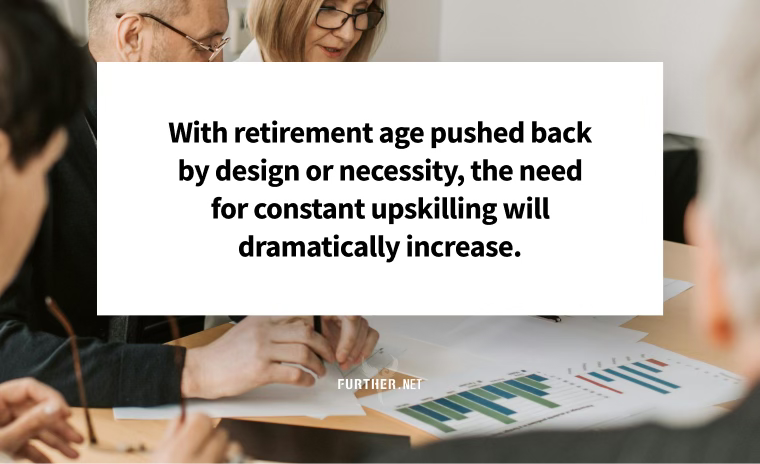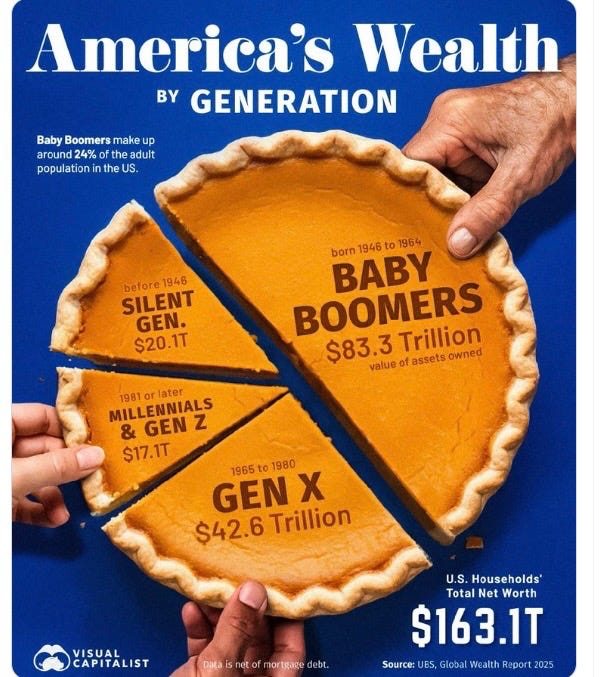Why “Long Life” Learning May Be the Key to Your Powerful Midlife Business
Online education is a $185.2 billion industry that’s about to further accelerate due to the longevity economy.
Online education is about to explode. Again.
And the time to start positioning yourself is now, so you’re not left behind.
It’s a $185.2 billion industry that’s hit the accelerator since the pandemic forced everyone online. For example, the online learning platform Coursera alone gained more than 20 million new registered learners in 2021, which equaled its total growth in the three years pre-pandemic.
And the momentum isn’t slowing down. It’s building. All of the forces that launched the online learning industry in the first place are still present, only more so.
Constant change, combined with broader consumer acceptance and more accessible digital platforms, means there’s plenty of room for further growth in online education, given that user penetration in the market was only 14.9% in 2024.
Now, get ready to add in the longevity economy effect. As a 50+ entrepreneur, you may find your ideal market is serving the needs of other 50+ people.
There are three key things to understand about the longevity economy:
A massive demographic shift toward an older society is underway. This trend will continue for decades, with the number of people over age 60 expected to more than double to 2.1 billion by 2050.
People over 50 control more than half of all consumer spending across major global economies.
Generation X will be the first cohort that works past traditional retirement age en masse, extending their “spendspan” in addition to their healthspan.
Maybe a visual metaphor will drive this home more effectively:
Marketers are obsessed with courting Millennials and Gen Z, but that’s not where the money is. This will change, and it will be 50+ entrepreneurs who reap the rewards of serving their own age groups.
Longer lives mean longer careers. And longer careers in an exponential technology environment mean one thing:
You’re either constantly learning, or you’re falling behind.
Plus, older consumers seeking new forms of meaning, purpose, and cognitive stimulation open the door to a myriad of unexplored educational opportunities.
In short, constant learning opportunities are something older consumers both need and want. And given the concentration of wealth held by the more seasoned generations, they have the financial means to invest in becoming better versions of themselves both professionally and personally.
From Lifelong Learning to “Long Life” Learning
We’ve grown up in a culture historically structured into three phases of life: learn, earn, and retire. But those phases are blurring together.
For one, retirement is undergoing a redefinition. As Stanford professor Susan Wilner Golden says in her book Stage (Not Age): How to Understand and Serve People Over 60—the Fastest Growing, Most Dynamic Market in the World, the “retire” phase itself is breaking into multiple stages of life, one of which is not retiring at all.
And to a certain extent, the “earn” stage has necessarily involved continued education, generally in a vocational setting — you learned on the job, picking up the information you needed. But now? The “earn” phase never stops requiring education. The idea of “lifelong learning” has been around since 1993, when Leslie Watkins coined the term “life-long learners.” But it’s evolved from an erudite concept into a non-negotiable reality. And it’s no coincidence that this shift lines up perfectly with the 30-year rise of the internet era.
In short, learning isn’t confined to childhood or the classroom anymore. It can’t be.
Of course, we’ve had various forms of remote adult education for centuries, also known as distance learning. The earliest correspondence course by mail dates back to 1728, and if you’ve ever seen the classic 1926 magazine ad by John Caples for the U.S. School of Music course (“They Laughed When I Sat Down At The Piano — But When I Started To Play!), you understand how powerful status benefits can sell loads of educational material to people well beyond “school age.”
It was the emergence of the social web that really sparked massive growth in online education. Back in 2007, I spent considerable time and effort convincing bloggers that online courses were the next big thing and an ideal product that content creators were uniquely qualified to build. I then had the privilege of training scores of “education entrepreneurs” who created businesses across a multitude of niches and topics.
The venture capital crowd didn’t get involved until years later – Udemy in 2010, Coursera in 2012, and celebrity-fueled “edutainment” company MasterClass in 2015. As mentioned, 2020 and the COVID-19 pandemic ultimately proved to be a mass tipping point, and yet there’s so much growth still ahead.
Part of that growth will come thanks to the longevity economy and the shift from lifelong learning to “long life” learning. We’re in the midst of a massive demographic shift. This escalating recomposition of society means a corresponding increase in the need for adaptive learning — real-time personalized learning experiences based on each student’s performance, responses, and progress.
And with retirement age being pushed back by design or necessity, the need for constant upskilling in the face of accelerated technological change and multinational business models will dramatically increase.
Plus, longer, healthier lives create learning opportunities for hobbies, entrepreneurship, and the pursuit of intellectual stimulation that enhances and preserves cognitive abilities.
The Opportunities for Midlife Education
People at midlife will be a prime market for a wide variety of online training. Generation X, in particular, will be the first cohort in modern times to work past age 65 en masse, even as employers are slow to understand that older workers are not only a necessity but a blessing.
That means continual knowledge acquisition and training for career reskilling and upskilling will be in high demand. Given that ageist hiring (and firing) practices are still the norm, combined with the fact that Generation X is the most entrepreneurial of the current cohorts, this should also lead to a strong demand for training related to self-employment and startups.
Courses related to personal development will also grow in demand for those at midlife. Middle age has long been misunderstood, defined in terms of crisis and the beginning of decline instead of the renaissance and reinvention period that the “midlife transition” really is.
And as time passes, the “new midlife” will stretch for many to age 75, and additional novel life stages will emerge. It also brings us a massive incoming wave: Once Millennials start turning 50 in 2030, expect exponential demand from that group.
It’s also important to note that middle-aged people are the most likely to change their attitudes on aging after being exposed to more authentic depictions of aging and older people. So, the initial education begins with your marketing content and messages. In this way, you’re not only priming them for “long life” learning, you’re also positioning yourself so they’re a customer for life.
Learning in Later Years
Much like the general advertising and marketing realm, online education for people commonly referred to as “elderly” is vastly misunderstood. Harmful stereotypes, such as “You can’t teach an older person new tricks,” or an assumption that they are incurious or too set in their way to learn new things, are just downright wrong.
It’s also a false stereotype that older people can’t handle the technology related to online learning. What’s true is that everyone will need constant training and retraining to keep up with rapid technological change, and older people are no different. This is especially the case with respect to healthcare technology.
Additionally, it’s important to understand that instructional content must be crafted appropriately for older people. That means educational content is a necessary part of every product, service, and experience targeted at older consumers.
Plus, as health spans increase for many people in their later years, the overlap with midlife vocational education will increase. There will be accessibility — formatting and presentation issues — to consider, but the subject matter will remain the same.
Much like healthy aging requires continued exercise for the body, older brains benefit from new and continual learning activities. Given extended lifespans, “long life” learning about anything of interest to older people has benefits in itself, regardless of the topic or resulting skill and knowledge. Unlike worthless brain games, well-designed online courses and training programs offer real mental stimulation that can help people avoid the cognitive decline that often accompanies age-related neurodegenerative diseases.
Keeping cognitively sharp promotes learning for its own sake, just as a segment of older adults with a positive attitude toward aging exercises for its own sake. This would also expand the segment of older people who are already natural lifelong learners, driven by a strong sense of curiosity.
Maximizing Your Wisdom and Expertise
Whether you’re relying on decades of experience or developing new expertise, don’t forget about your crystallized intelligence. This is your greatest asset when it comes to educating others as part of a winning business model.
Crystallized intelligence is the ability to use the vast set of knowledge and experience you’ve acquired over the years, and it tends to increase with age through one’s forties, fifties, and sixties. Plus, it doesn’t diminish until quite late in life, if ever.
Basically, when we’re young, we have raw processing power. But now, we have the wisdom to do more than simply generate and process facts. We know what those facts mean and how to use them.
This is why you’ll see college professors older than 65 who are still going strong. What’s more, a study in The Chronicle of Higher Education shows that the oldest college professors tend to have the best teaching evaluations.
That’s because their crystallized intelligence allows them to be much better teachers than their younger colleagues. A younger professor may have a powerful processor, but lacks the ability to synthesize and explain complex information as well as their older counterparts.
In his book Strength to Strength: Finding Success, Happiness and Deep Purpose in the Second Half of Life, Arthur C. Brooks explores what we lose and gain at midlife. In discussing the diminishment of fluid intelligence and the power of crystallized intelligence, he offers this advice:
There always exists the ability to redesign your career less on innovation and more on instruction as the years pass, thus playing to your strengths with age.
Devote the back half of your life to serving others with your wisdom. Get old sharing the things you believe are most important. Excellence is always its own reward, and this is how you can be most excellent as you age.
That’s why the Business of Expertise Blueprint caters specifically to those with crystalized intelligence, while providing the ideal location-independent freedom that makes traditional retirement look silly.
Fortunately, online courses and other premium educational experiences are all components of the broader Business of Expertise, and Further Premium can get you on the right path fast. Join us here.
Keep going-
P.S. I’m now officially 58, but it’s just another day… because I’m at the beach. 😎
further: flashback
🎶 Metallica - One, …And Justice for All, 1988 🎶
No song rocks harder than Metallica’s One does… eventually. (YouTube)
further: sharing
Enjoy this issue? Please forward this email to friends or share by clicking below:
Or you can earn access to Further Premium by recommending Further in general.
Grab your unique referral code here.
Thank you for sharing Further!





Brian, you might enjoy Season 10 of my 4-Quarter Lives podcast. Am chatting with the directors of all the major universities’ launching new midlife transition programs. They are leading the way on long life learning…
Thank you for such a comprehensive, quantifiable look at the enormous possibilities and opportunities to learn and grow well into the years we used to think of as “out to pasture.” We’re finally figuring out the 4th Quarter, 75+, can be a huge benefit (and economic engine) in our society.